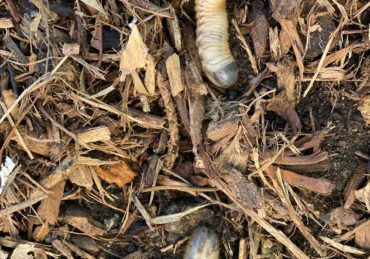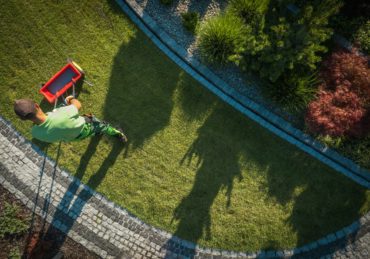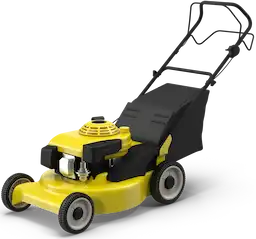2025’s Definitive Guide to Annual Lawn Maintenance
If your goal is to have your lawn be the envy of the neighborhood – this guide is your rubric to success.
At LawnGuru we get asked all the time what do you need to do to make your lawn shine, so we’ve compiled this guide to help you get started no matter what time of year it is.
Use this guide like an owner’s manual for your lawn.

Spring
While the calendar year begins in winter most of us start thinking about taking care of our yards in early spring as the temperatures start to rise, so that’s where we’ll start too. Spring is also foundational to your lawn’s performance for the rest of the year.
The services to perform or order in the spring for a great looking lawn are;
- Grub, Insect & Weed Pre-treatment
- Aeration & Overseeding
- Grass Fertilizer
- Spring Clean Up
- Mulching
- Sprinkler Start-Up
Grub, Insect & Weed Pre-Treatment
As soon as any possible frost is in the rear view mirror, it’s time to put down pre-treatment before anything else. This will eliminate the risks posed to your lawn by hungry naturally occurring pests and insects while also blocking weeds from taking root. If you’ve ever wondered how one lawn can be coated in dandelions next to a lawn with none, the pre-treatment is the answer.
Aeration & Overseeding
If you didn’t get an aeration and overseeding service in the previous fall, early to mid spring is also the right time to get these both knocked out simultaneously. That way you’ve decreased competitors for your lawn and optimized the grass’s ability to create a lush homogenous carpeting; the kind of lawn you walk through barefoot all summer long! If you have any bare patches, break the soil up and coat with the same seeds to get them healing now too.
For our customers in Michigan, Minnesota, Ohio, Illinois, Pennsylvania, Maryland or Virginia the work above is typically done between late March and April.
For our customers in the warmer climates of Georgia, Florida, North Carolina or Texas this is usually a late February to early April to do.
Lawn Fertilizer
Once you’re a few weeks (at least 3!) past the aeration and overseeding, it’s time to begin a fertilizer regime for the rest of the lawn season. The frequency totally depends on what products or services you’re using – some are meant to be applied monthly while others last most of the season. You just don’t want to overdo it and risk burning the lawn and shocking the grass with a nutrient overload. If you over apply, you’re also typically losing a lot of what’s applied as it washes away with the rain once the lawn is saturated.
Spring Clean Up & Mulching
Your lawn is just like a fine dining experience or luxury good; to really make stand out the difference is in the details of presentation.
This is where spring clean ups and mulching shine – the time and effort or cost is worth it to match your lush green lawn. Spring clean ups just remove all the leaves and sticks from your lawn and garden beds, leaving them clean and free of clutter.
If you’ve got mulch in your garden beds, it’s something that needs regular refreshing too. Mulch isn’t designed to last more than a couple years so put down another layer to keep your beds looking fresh and making it more difficult for weeds to take root. Depending on the plants in your landscape beds, you can also do an anti-weed treatment that won’t affect them. We generally advise against using harsh chemicals in garden beds.
If there’s one season that matters most, it’s spring. Hitting these early will give your lawn a leg up for the rest of the year and will maximize your curb appeal so you can win at being a neighbor, graduation parties, selling your house and more!
Sprinkler Start-Up
As with the pre-treatment, once the frost is in the rear view mirror for the season it’s time to get your in-ground sprinkler system blown out and turned back on. This is fairly simple but does require a capable air compressor and the right tools to connect it to your system. Once the pipes are cleared of any debris, just open the water valve and you’re back in business.
Summer
Consistency is vital to success in every endeavor, including your lawn! If you’ve started the season off right this should feel more like cruise control than battling through rush hour traffic.
The services or to-dos to hit in the summer for a lush green lawn are;
- Lawn fertilization
- Hedge Trimming
- Regular lawn mowing
- Regular watering
Lawn Fertilization
Depending on the solution you’ve chosen, this may be something you only do once or twice or require monthly repetition. It’s vital to just pay attention to the program or products you’ve chosen. If you make a change for any reason, say going from a professional fertilizer treatment to DIY, just pay attention to the last service date and take a minute to understand what your provider was using to inform your product selection and timing.
Hedge Trimming
By early summer, your hedges and landscaping plants should have all started on this year’s growth. Hitting the trimming now should last for most of the season if not all, especially in the northern continental United States. Just shape your plants without taking too much off, to prevent shock, and bag up the debris and cuttings.
Regular Lawn Mowing
This may seem obvious but there are few details that merit mentioning. It’s important to pay some attention to how fast your grass is growing. During early summer, for example grass grows more quickly whereas in peak heat and dryer summer months the growth will slow.
Regular mowing promotes a thick lush lawn – the grass continues to focus on growth instead of optimizing for seed production and success too!
You want to regularly be cutting the grass at about the same height, before the seeds appear at the top of the blades of grass, and never taking too much off the top. Letting the grass grow tall creates competition and may lead to yellow spots after a cut. The grass that is below the visible surface isn’t getting much light and naturally hardens to hold up the top of the blade. Conversely, cutting it too short or taking off too much at once can burn the lawn and shock the grass.
For customers in our northern markets, such as Michigan, Minnesota, Ohio, Illinois, Pennsylvania, Maryland or Virginia we’re typically mowing on a weekly cadence April through June and in July switch to bi-weekly cuts or see a higher rate of skips as customers notice they don’t need a cut in a given week.
For customers in our southern markets, such as Georgia, Florida, North Carolina or Texas we’re typically mowing at a weekly cadence most of the summer and toggle to bi-weekly or see skips increase during dry spells.
Regular watering
This may feel obvious, but is vital and thus merits mentioning. Plus we get asked all the time when is the best time to water the lawn.
The best time to do it is in the morning, after the sunrise but before 10am. This way the grass is active and able to put the water to work – capturing more of what gets into the soil than it does at night. It also minimizes evaporation and prevents the damage that can be done by long sunny days.
If you’re like me, and live in an area which gets plenty of rain most of the summer and don’t regularly use an in ground sprinkler system, just make sure you’re watering the lawn in the morning during those weeks long high-heat dry spells.
Fall
As temperatures cool and the leaves begin to change, so too do your lawn’s needs. If you’ve followed our annual guide for your lawn this far, you know just how well it works. Now is the time to make sure your lawn is prepared for winter and ready to thrive when spring returns.
Your lawn’s internal clock and behavior is tied to the sun. As the days begin to shorten earlier in the summer, the grass starts changing internally!
In the fall the services and work to perform on the lawn are as follows;
- Aeration & overseeding
- Fall clean up
- Planting
- Final cut for the season
Aeration & Overseeding
If you’ve been following our definitive guide to a lush lawn, then you know we listed this in the spring to-dos too. You can hit it twice a year for best results – it’s really just vital to do with regularity so oxygen and nutrients can penetrate the thick bottom most layer of grass into the soil.
If you’re just getting focused on the lawn and it’s later in the fall, we’d recommend doing aeration and overseeding together before winter sets in. This is really the best time for those seeds to go down, it mirrors the natural cycle of getting into the ground in before winter and sprouting in the spring.
Fall Clean Up
This is another repeat from the spring list, and is less important to the grass now than it is to the overall curb appeal of your home and preventing problems in the spring.
As in the spring, we’re removing leaves and sticks from the lawn and garden bed this time of year. While the leaves offer some nutrient value to the lawn, they’re also an eyesore and can accumulate in piles that block out all the sun, get wet and turn into a solid membrane, and then completely kill the grass underneath. These spots are also a hotbed for insects and pests which are drawn to the damp nutrient rich patches.
Once the patch has formed, you’ll have to break it up, remove it and then
This is also true for your landscaping beds – where the leaves accumulate and cause the same types of problems. Rather than killing grass, they rot and turn into soil which then offers weeds and pests a home on top of your mulch or landscaping rocks. Over time this will accumulate and is how beds turn into lawn or wild growth so it’s important to stay on top of.
Planting
Late in the fall, larger plants have gone dormant in preparation for winter. This decreases their sensitivity and susceptibility to shock compared to spring or summer and makes this the best time to plant new landscaping shrubs, trees or bushes.
Final Cut For the Season
At the end of the mowing season, for your last lawn mowing, you want to break from the norm and cut the grass as short as reasonably possible without scalping to the dirt. This makes life easier for your lawn in the spring and improves the viability of each individual plant – there’s less to keep alive above the surface or to restore come the spring. We aim for 1.5” average grass length for the final cut of the season. You should mulch the clippings down as usual, returning the nutrients to the soil and priming the roots for success in spring. If you’re aerating atleast annually, there’s no risk of building up a thick underlayer of dead grasses that many “neighborhood experts” will caution new home owners about.
Winter
Winter has come, and you’re wanting to make sure your lawn is as lush and healthy as possible again next year. Thankfully, if you’ve followed our guide to this point – you’ve got little to do to repeat your success.
In the winter these are the services you’ll need to book or do yourself;
- Winterize Sprinklers
- Burlap Wrap Plants
Conclusion
Now that you’ve reached the end, perhaps of your calendar year, congratulations. You’re in the know and ready to make your lawn shine year in and year out. If you want, you can even tell people to get off your lawn! Just kidding – a great lawn is a great place to enjoy!





